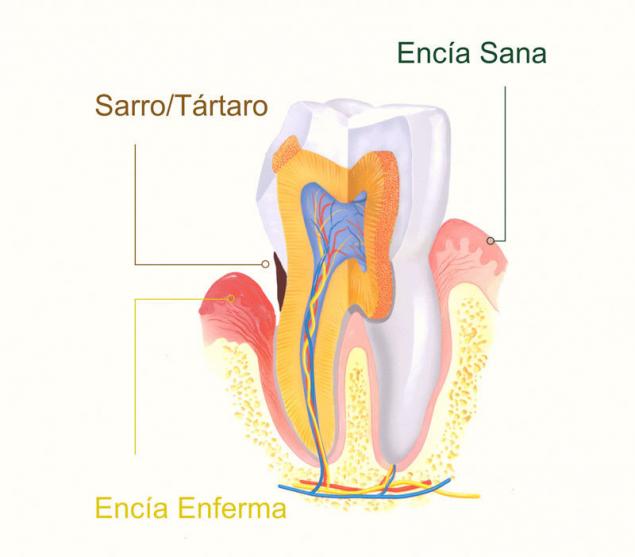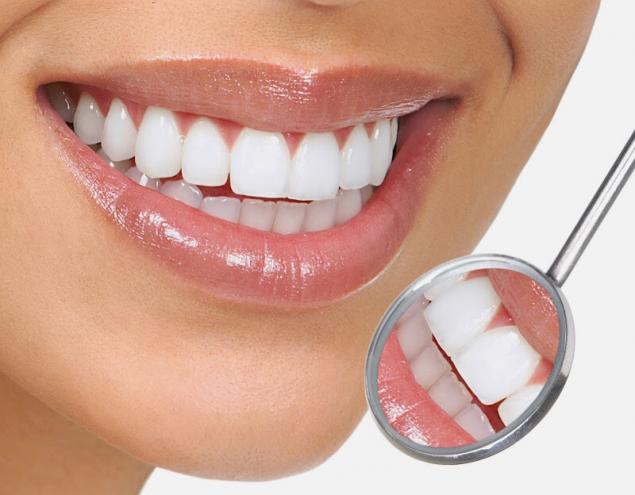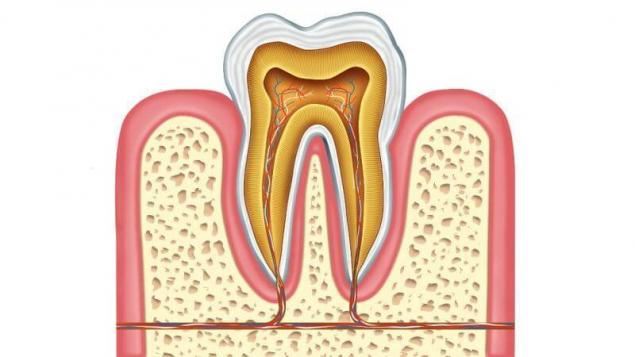1607
Natural treatment of caries - a stunning and sometimes shocking facts!
The author gives a stunning and sometimes shocking facts of modern dentistry and alternative methods of treatment of caries. The bacteria do not cause tooth decay, teeth have the ability to self-healing and a healthy form of special liquid is purified themselves.
Part 1. Causes of dental caries and tooth remineralization basics
Warning: the bacteria are not the main cause of tooth decay

The fundamental theory of modern dentistry has been bred in 1883 doctor VD Miller. He found that if you put the extracted tooth in a mixture of fermented bread and saliva on the tooth there is something similar to tooth decay. He suggested that the acid secreted by microorganisms in the mouth, decompose the dental tissue. However, Dr. Miller himself never believed that bacteria are the cause of tooth decay. Rather, he believed that bacteria and emissions of acid involved in the process of tooth decay. But most importantly - he believed that a strong tooth can not be destroyed
. Dr. Miller that a strong and tight tooth can withstand the "indefinitely" any acid, whether from bacteria or food. At the same time, the tooth does not possess a dense structure would quickly succumb to the effects of acid, regardless of its origin. Dr. Miller also wrote that "the invasion of the microorganism is always preceded by a reduction in the amount of mineral salts." Simply put, the first tooth loses minerals, and then the micro-organisms can cause harm.
One hundred twenty years of dental science adheres to Dr. Miller's theory, losing the most essential information. It is now believed that dental caries is caused when foods containing carbohydrates (sugars and starches) such as milk, carbonated drinks, raisins, cakes, candies, often remain on the teeth. They create a beneficial environment for the bacteria that result in the ability to live produce acid. Over time, these acids destroy tooth enamel and lead to the formation of dental caries.
The difference between the proposed 1883 Dr. theory Miller year, and the theory, which adhere to the dentist today, is that the protection of teeth from destruction is provided by the density and structure of the tooth structure, whereas today, dentists are taught that only bacteria are cause tooth decay. Dentists believe that dental caries is almost nothing to do with food, except perhaps the fact that the food sticks to teeth.

The modern theory of decay even collapses because white sugar actually has the ability to neutralize microorganisms, since attracts water. The microorganisms are killed in a 20-percent solution of sugar. The bacteria are actually present in the destruction of the teeth, as its consequence, but a large amount of sugar consumed at one time, kills them. If the dentist does not err on the role of bacteria in the development of caries, the diet is high in sugar should lead to their destruction.
Bacteria are ubiquitous, and from them is almost impossible to get rid of. Currently, dental disease associated with more than 400 different species of bacteria, and still not detected. Since bacteria, good and bad, are an integral part of our lives and trillions, the strategy of destruction, which adhere to the current dentists, it seems hopeless.
In 1922, a dentist Percy Howe read out to the American Dental Association report, in which he noted that his research team tried unsuccessfully to reproduce the process of tooth decay in guinea pigs. The animals through food and vaccinations were administered different types of bacteria, the presence of which is usually associated with gum disease and tooth decay. He said that "there was not a single case in which they have failed to prove the presence of dental disease by using these methods." On the other hand, Dr. Howie quite easily achieved caries in guinea pigs, excluding from their diet vitamin C.
The idea of the role of bacteria in the destruction of the tooth was taken from Dr. Miller's research, but has never been proven. A competing theory at that time was the so-called theory of proteolysis and chelation therapy proposed by Dr. Albert Shatsem. According to this theory, enzymes (rather than bacteria), and chelating agents which are present in vegetable and animal products (no acids) are the cause of tooth decay. In theory, Dr. Schatz nutrition, trace elements and hormonal balance are the key factors that trigger the production of enzymes and removal of minerals from the tooth tissue, thus leading to the formation of dental caries.
From 1954 to the present day research work, who devoted his life Dr. Ralph Steinman and his colleague Dr. John Leonora proves that caries develops as a result of physiological processes occurring in our body when we consume food. With the pituitary hypothalamus in our brain regulates the relationship between the nervous system and glands. Dr. Leonora and Steinman found that the hypothalamus communicates with the parotid gland by releasing factor hormone parotina. When the hypothalamus sends a signal to the salivary glands, they begin to allocate parotin that stimulates the movement of lymph dental, rich in minerals, in microscopic tubules inside the tooth. This fluid cleans the tooth tissue and remineralizes it.
When we consume foods that cause tooth decay, the hypothalamus stops to stimulate the release parotina which helps circulation tooth remineralizes liquid. Over time, the delay in the development of dental lymph leads to tooth decay, which we call tooth decay. The fact that the parotid salivary glands are responsible for the mineralization of teeth, explains why some people are resistant to decay, even at relatively meager diet, they have a very healthy birth parotid salivary gland.
The experiments that Dr. Steinman conducted on rats, showed that although the bacteria and produce acid, the relationship between this acid and presence of caries is absent.
Speaking with full responsibility, it should be noted that if the microbes are the cause of the patients teeth, humanity and will continue to be the victim of a terrible epidemic of dental caries. Conversely, if we understand that the cause of tooth decay is the food, we will have full control over the treatment and prevention of dental caries.
With age, tooth decay affects more and more the number of teeth. With aging, we lose more teeth. With the exception of wisdom teeth, people aged 20 to 39 years old on average, have lost one tooth, from 40 to 59 years old - not count up three and a half teeth; and those who are over 60 -. the eight teeth
Depressing and additional statistics, destruction of teeth in people over 40 years. On average, people in this age group are subject to decay 45, 89% of the teeth.
One could make the argument that the increase in carious teeth with age is due to natural aging of the organism, however, it does not explain why in our time is growing incidence of tooth decay among young children. Between 1988-1994 and 1999-2004 the number of years of primary teeth in children aged 2 to 5 years increased from 24 to 28%. Along with the increasing incidence of increased attendance of dentists. If tooth decay is related to the aging process, why it suffers from the increasing number of children? And why the growth rate of dental interventions in these children does not stop further tooth decay?
Foundations of remineralization of teeth
Let's see how to construct the teeth in order to well understand the formation of dental caries (demineralization) and the process of reconstruction of damaged dental tissue (remineralization).
Dentin - this is a solid and similar to the bones of the middle layer of the tooth
. Enamel - a hard white shell tooth
. The root of the tooth is embedded in the jaw.
In the middle of a tooth is the pulp. Inside it - blood vessels, nerves, and cell components, including cell growth necessary for tooth
.
Each tooth is provided with blood and nerve which passes through the root center, connected to the mandibular nerve. Mandibular (and maxillary) nerve is a branch of the trigeminal, the largest nerve in our head. This neural connection and makes steel strong toothache and exhausting.
The root of the tooth is surrounded by the periodontal ligament. With millions of diverging in different directions of the elastic fibers of this ligament attaches the tooth to the jaw. These fibers are distributed chewing load and firmly hold the tooth in its hole. Periodontal ligament cells have the ability to recover and degenerate. Depreciation of the periodontal ligament is the primary cause of tooth loss.
Each tooth contains about 4, 8 km microscopic tubes called dentinal tubules. The diameter of dentinal tubules is 1, 3.4 and 5 microns. This is about one-thousandth the size of a pinhead. Dentinal tubules filled with fluid, which presumably has a composition similar to the cerebrospinal fluid surrounding the brain and spinal cord. tooth enamel contains about 2% of the liquid. In addition to the special fluid in the tubules of these may be the components required for the growth of the tooth, the tooth nerve and connective tissue.
Power dentin and enamel is achieved through special building cells called odontoblasts. They transfer or distribute certain nutrients for dental lymph. Odontoblasts contain microscopic structures that function as a pump. As a result, a healthy tooth cleans itself. Microscopic nutrient liquid droplets released from our blood is pumped through the ducts. A healthy tooth, this pressurized fluid from the pulp moves in the direction of enamel, protecting teeth against corrosive substances present in the oral cavity. * The teeth of the upper jaw are innervated by the maxillary nerve. (Approx. Interpreter).
Dentist Ralph M. Steinman found that the ability to remineralization of teeth based on the regulatory function of the largest salivary was -. Parotid
Located in the back of the jaw, the parotid gland regulate the activities of dentinal fluid, rich in nutrients. The signal comes from the parotid gland regulating center of the brain, the hypothalamus. When the team of the parotid salivary glands tooth movement fluid starts to go in the opposite direction (as a result of poor nutrition or other reason), the food debris, saliva and other substances are tightened on the tubules inside the tooth. Over time, the pulp is inflamed, and the destruction extends to the enamel.
Doctor Staynman found that the destruction process is associated with the loss of several key minerals - magnesium, copper, iron and manganese. All these elements are actively involved in the cellular metabolism and energy needed for production, which provides the movement of the cleaning liquid on dentin tubules. It should be noted that phytic acid contained in cereals, nuts, seeds and legumes, has the ability to block the absorption of these minerals extremely important.
In this regard, tooth decay should be assigned to a different category of diseases in order to give a precise definition of this phenomenon. The traditional definition of caries as a disease has an infectious-bacterial nature, is false.
Part 2: Hormones and tooth decay
One of the achievements of Dr. Melvin Page, was the discovery of the connection between hormones, glands, and tooth decay. Dr. Paige found that when disturbed balance in the endocrine (hormone-producing), people develop tooth decay or gum disease. Studies by Dr. Staynmana showed that the process of tooth decay starts glands. Therefore, taking care of the health of the glands, we can stop tooth decay.
Pituitary
Dr. Paige realized the importance of the functioning of the pituitary gland - the main glands of the endocrine system, and two separate share - front and back, each of which produces certain hormones
. One of the functions performed by the posterior lobe of the pituitary together with the pancreas, is to regulate blood sugar levels. Chronically elevated blood sugar often leads to tooth decay or gum disease. If the posterior pituitary can not properly regulate blood sugar, which may lead to a biochemical imbalance, resulting in the bones will lose phosphorus. The main cause of the posterior pituitary insufficiency is white refined sugar.
The cause of gum disease is a hyperactive anterior pituitary. One of the functions of the anterior lobe is growth hormone. The activities of the pituitary is regulated by testosterone or estrogen. Therefore, insufficient production of growth hormone are closely linked to gum disease.
Reducing the amount of sugar consumed, including natural sugars, can gradually restore the health of the posterior lobe of the pituitary gland.
Thyroid
The activity of the thyroid gland is regulated by the anterior pituitary gland. Often the relationship of thyroid and pituitary is ignored, which is why the treatment of thyroid problems is ineffective. Not proper operation of the thyroid gland may lead to the development of tooth decay and gum disease, because the iron is involved in the regulation of calcium levels in the blood. To restore the normal function of the thyroid gland, as a rule, you must pay attention to the work of the anterior pituitary. People who take medications that affect the thyroid gland, can cause significant problems with dental health.
Gonads
Excess testosterone can lead to gum disease and an increased level of calcium in the blood. Gum disease may also be associated with an excess of estrogen.
Restoration of normal function of glands
The reason for a special interest in the work of the glands is that drugs, hormonal contraceptives and other toxic substances can seriously affect one or more glands, worsening the condition of our teeth. Correct operation of these important glands provide support to the parotid gland and thus will contribute to the remineralization of teeth. If you feel that your glands do not work smoothly, or if you are taking medications that affect their function, in addition to the power you will need to undergo additional treatment. The use of herbs and dietary supplements to maintain the function of the glands, as well as traditional methods of Ayurveda, Tibetan and Chinese medicine, including acupuncture, under the guidance of a good specialist can help to strengthen the prostate and organize their work.
Cholesterol
Cholesterol is an essential component necessary for hormone production. He needed to hormones to function properly. This is not a deadly poison, but a substance vital to the cells of all mammals. There is no evidence that too much animal fat and cholesterol in the diet causes atherosclerosis or heart attacks.
Many of us are afraid to mistakenly eat tasty foods, because they contain a substance is required. Our body produces three - four times more cholesterol than we consume with food. If we consider the matter more deeply, we can see that the cholesterol contained in healthy fats, is not dangerous, and that the level of cholesterol in the blood has no relation to the incidence of heart disease.
Author: Ramiel Neygel
Part 1. Causes of dental caries and tooth remineralization basics
Warning: the bacteria are not the main cause of tooth decay

The fundamental theory of modern dentistry has been bred in 1883 doctor VD Miller. He found that if you put the extracted tooth in a mixture of fermented bread and saliva on the tooth there is something similar to tooth decay. He suggested that the acid secreted by microorganisms in the mouth, decompose the dental tissue. However, Dr. Miller himself never believed that bacteria are the cause of tooth decay. Rather, he believed that bacteria and emissions of acid involved in the process of tooth decay. But most importantly - he believed that a strong tooth can not be destroyed
. Dr. Miller that a strong and tight tooth can withstand the "indefinitely" any acid, whether from bacteria or food. At the same time, the tooth does not possess a dense structure would quickly succumb to the effects of acid, regardless of its origin. Dr. Miller also wrote that "the invasion of the microorganism is always preceded by a reduction in the amount of mineral salts." Simply put, the first tooth loses minerals, and then the micro-organisms can cause harm.
One hundred twenty years of dental science adheres to Dr. Miller's theory, losing the most essential information. It is now believed that dental caries is caused when foods containing carbohydrates (sugars and starches) such as milk, carbonated drinks, raisins, cakes, candies, often remain on the teeth. They create a beneficial environment for the bacteria that result in the ability to live produce acid. Over time, these acids destroy tooth enamel and lead to the formation of dental caries.
The difference between the proposed 1883 Dr. theory Miller year, and the theory, which adhere to the dentist today, is that the protection of teeth from destruction is provided by the density and structure of the tooth structure, whereas today, dentists are taught that only bacteria are cause tooth decay. Dentists believe that dental caries is almost nothing to do with food, except perhaps the fact that the food sticks to teeth.

The modern theory of decay even collapses because white sugar actually has the ability to neutralize microorganisms, since attracts water. The microorganisms are killed in a 20-percent solution of sugar. The bacteria are actually present in the destruction of the teeth, as its consequence, but a large amount of sugar consumed at one time, kills them. If the dentist does not err on the role of bacteria in the development of caries, the diet is high in sugar should lead to their destruction.
Bacteria are ubiquitous, and from them is almost impossible to get rid of. Currently, dental disease associated with more than 400 different species of bacteria, and still not detected. Since bacteria, good and bad, are an integral part of our lives and trillions, the strategy of destruction, which adhere to the current dentists, it seems hopeless.
In 1922, a dentist Percy Howe read out to the American Dental Association report, in which he noted that his research team tried unsuccessfully to reproduce the process of tooth decay in guinea pigs. The animals through food and vaccinations were administered different types of bacteria, the presence of which is usually associated with gum disease and tooth decay. He said that "there was not a single case in which they have failed to prove the presence of dental disease by using these methods." On the other hand, Dr. Howie quite easily achieved caries in guinea pigs, excluding from their diet vitamin C.
The idea of the role of bacteria in the destruction of the tooth was taken from Dr. Miller's research, but has never been proven. A competing theory at that time was the so-called theory of proteolysis and chelation therapy proposed by Dr. Albert Shatsem. According to this theory, enzymes (rather than bacteria), and chelating agents which are present in vegetable and animal products (no acids) are the cause of tooth decay. In theory, Dr. Schatz nutrition, trace elements and hormonal balance are the key factors that trigger the production of enzymes and removal of minerals from the tooth tissue, thus leading to the formation of dental caries.
From 1954 to the present day research work, who devoted his life Dr. Ralph Steinman and his colleague Dr. John Leonora proves that caries develops as a result of physiological processes occurring in our body when we consume food. With the pituitary hypothalamus in our brain regulates the relationship between the nervous system and glands. Dr. Leonora and Steinman found that the hypothalamus communicates with the parotid gland by releasing factor hormone parotina. When the hypothalamus sends a signal to the salivary glands, they begin to allocate parotin that stimulates the movement of lymph dental, rich in minerals, in microscopic tubules inside the tooth. This fluid cleans the tooth tissue and remineralizes it.
When we consume foods that cause tooth decay, the hypothalamus stops to stimulate the release parotina which helps circulation tooth remineralizes liquid. Over time, the delay in the development of dental lymph leads to tooth decay, which we call tooth decay. The fact that the parotid salivary glands are responsible for the mineralization of teeth, explains why some people are resistant to decay, even at relatively meager diet, they have a very healthy birth parotid salivary gland.
The experiments that Dr. Steinman conducted on rats, showed that although the bacteria and produce acid, the relationship between this acid and presence of caries is absent.
Speaking with full responsibility, it should be noted that if the microbes are the cause of the patients teeth, humanity and will continue to be the victim of a terrible epidemic of dental caries. Conversely, if we understand that the cause of tooth decay is the food, we will have full control over the treatment and prevention of dental caries.
With age, tooth decay affects more and more the number of teeth. With aging, we lose more teeth. With the exception of wisdom teeth, people aged 20 to 39 years old on average, have lost one tooth, from 40 to 59 years old - not count up three and a half teeth; and those who are over 60 -. the eight teeth
Depressing and additional statistics, destruction of teeth in people over 40 years. On average, people in this age group are subject to decay 45, 89% of the teeth.
One could make the argument that the increase in carious teeth with age is due to natural aging of the organism, however, it does not explain why in our time is growing incidence of tooth decay among young children. Between 1988-1994 and 1999-2004 the number of years of primary teeth in children aged 2 to 5 years increased from 24 to 28%. Along with the increasing incidence of increased attendance of dentists. If tooth decay is related to the aging process, why it suffers from the increasing number of children? And why the growth rate of dental interventions in these children does not stop further tooth decay?
Foundations of remineralization of teeth
Let's see how to construct the teeth in order to well understand the formation of dental caries (demineralization) and the process of reconstruction of damaged dental tissue (remineralization).
Dentin - this is a solid and similar to the bones of the middle layer of the tooth
. Enamel - a hard white shell tooth
. The root of the tooth is embedded in the jaw.
In the middle of a tooth is the pulp. Inside it - blood vessels, nerves, and cell components, including cell growth necessary for tooth
.

Each tooth is provided with blood and nerve which passes through the root center, connected to the mandibular nerve. Mandibular (and maxillary) nerve is a branch of the trigeminal, the largest nerve in our head. This neural connection and makes steel strong toothache and exhausting.
The root of the tooth is surrounded by the periodontal ligament. With millions of diverging in different directions of the elastic fibers of this ligament attaches the tooth to the jaw. These fibers are distributed chewing load and firmly hold the tooth in its hole. Periodontal ligament cells have the ability to recover and degenerate. Depreciation of the periodontal ligament is the primary cause of tooth loss.
Each tooth contains about 4, 8 km microscopic tubes called dentinal tubules. The diameter of dentinal tubules is 1, 3.4 and 5 microns. This is about one-thousandth the size of a pinhead. Dentinal tubules filled with fluid, which presumably has a composition similar to the cerebrospinal fluid surrounding the brain and spinal cord. tooth enamel contains about 2% of the liquid. In addition to the special fluid in the tubules of these may be the components required for the growth of the tooth, the tooth nerve and connective tissue.
Power dentin and enamel is achieved through special building cells called odontoblasts. They transfer or distribute certain nutrients for dental lymph. Odontoblasts contain microscopic structures that function as a pump. As a result, a healthy tooth cleans itself. Microscopic nutrient liquid droplets released from our blood is pumped through the ducts. A healthy tooth, this pressurized fluid from the pulp moves in the direction of enamel, protecting teeth against corrosive substances present in the oral cavity. * The teeth of the upper jaw are innervated by the maxillary nerve. (Approx. Interpreter).
Dentist Ralph M. Steinman found that the ability to remineralization of teeth based on the regulatory function of the largest salivary was -. Parotid
Located in the back of the jaw, the parotid gland regulate the activities of dentinal fluid, rich in nutrients. The signal comes from the parotid gland regulating center of the brain, the hypothalamus. When the team of the parotid salivary glands tooth movement fluid starts to go in the opposite direction (as a result of poor nutrition or other reason), the food debris, saliva and other substances are tightened on the tubules inside the tooth. Over time, the pulp is inflamed, and the destruction extends to the enamel.
Doctor Staynman found that the destruction process is associated with the loss of several key minerals - magnesium, copper, iron and manganese. All these elements are actively involved in the cellular metabolism and energy needed for production, which provides the movement of the cleaning liquid on dentin tubules. It should be noted that phytic acid contained in cereals, nuts, seeds and legumes, has the ability to block the absorption of these minerals extremely important.
In this regard, tooth decay should be assigned to a different category of diseases in order to give a precise definition of this phenomenon. The traditional definition of caries as a disease has an infectious-bacterial nature, is false.
Part 2: Hormones and tooth decay
One of the achievements of Dr. Melvin Page, was the discovery of the connection between hormones, glands, and tooth decay. Dr. Paige found that when disturbed balance in the endocrine (hormone-producing), people develop tooth decay or gum disease. Studies by Dr. Staynmana showed that the process of tooth decay starts glands. Therefore, taking care of the health of the glands, we can stop tooth decay.
Pituitary
Dr. Paige realized the importance of the functioning of the pituitary gland - the main glands of the endocrine system, and two separate share - front and back, each of which produces certain hormones
. One of the functions performed by the posterior lobe of the pituitary together with the pancreas, is to regulate blood sugar levels. Chronically elevated blood sugar often leads to tooth decay or gum disease. If the posterior pituitary can not properly regulate blood sugar, which may lead to a biochemical imbalance, resulting in the bones will lose phosphorus. The main cause of the posterior pituitary insufficiency is white refined sugar.
The cause of gum disease is a hyperactive anterior pituitary. One of the functions of the anterior lobe is growth hormone. The activities of the pituitary is regulated by testosterone or estrogen. Therefore, insufficient production of growth hormone are closely linked to gum disease.
Reducing the amount of sugar consumed, including natural sugars, can gradually restore the health of the posterior lobe of the pituitary gland.
Thyroid
The activity of the thyroid gland is regulated by the anterior pituitary gland. Often the relationship of thyroid and pituitary is ignored, which is why the treatment of thyroid problems is ineffective. Not proper operation of the thyroid gland may lead to the development of tooth decay and gum disease, because the iron is involved in the regulation of calcium levels in the blood. To restore the normal function of the thyroid gland, as a rule, you must pay attention to the work of the anterior pituitary. People who take medications that affect the thyroid gland, can cause significant problems with dental health.
Gonads
Excess testosterone can lead to gum disease and an increased level of calcium in the blood. Gum disease may also be associated with an excess of estrogen.
Restoration of normal function of glands
The reason for a special interest in the work of the glands is that drugs, hormonal contraceptives and other toxic substances can seriously affect one or more glands, worsening the condition of our teeth. Correct operation of these important glands provide support to the parotid gland and thus will contribute to the remineralization of teeth. If you feel that your glands do not work smoothly, or if you are taking medications that affect their function, in addition to the power you will need to undergo additional treatment. The use of herbs and dietary supplements to maintain the function of the glands, as well as traditional methods of Ayurveda, Tibetan and Chinese medicine, including acupuncture, under the guidance of a good specialist can help to strengthen the prostate and organize their work.
Cholesterol
Cholesterol is an essential component necessary for hormone production. He needed to hormones to function properly. This is not a deadly poison, but a substance vital to the cells of all mammals. There is no evidence that too much animal fat and cholesterol in the diet causes atherosclerosis or heart attacks.
Many of us are afraid to mistakenly eat tasty foods, because they contain a substance is required. Our body produces three - four times more cholesterol than we consume with food. If we consider the matter more deeply, we can see that the cholesterol contained in healthy fats, is not dangerous, and that the level of cholesterol in the blood has no relation to the incidence of heart disease.
Author: Ramiel Neygel
Three levels of consciousness - three different levels of life
Ekoapartamenty Leonardo DiCaprio. Natural luxury in every meter!























